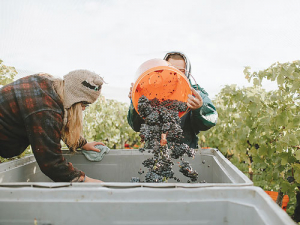Now winegrowers in the area are being asked to think now about their future labour needs.
The Central Otago District Council has partnered with sector groups to get up-to-date information on crop plantings and associated labour demands, and all grape growers and contractors, and orchardists, are being asked to have their say by filling in and returning the survey forms they have been sent.
A similar survey three years ago had proved to be “remarkably accurate,” said Martin Anderson of Cromwell, who, with Tara Druce of Druce Consulting, has updated the questionnaire. The 2015 report highlighted labour supply as an “ongoing and growing fragility in the sector” and there is every indication the situation is worsening, says Anderson.
As in other regions there is an interdependence between the horticulture and viticulture industries, and whilst grape plantings may be tracking along pretty much as expected (“modest” growth) - it’s a different story with horticulture which is on a roll, with no end to its expansion in sight.
The total estimated hectares for all fruit types is approaching the total area in grapes, around 2000 ha, boosted by cherry developments and a resurgence in apple plantings.
Orchardists and grape growers access the same labour pool to help out with seasonal peak times, with spikes in a “normal” year in January when cherries and stone fruit are harvested, and in the April grape and apple harvest.
Seasonal Solutions is by far the biggest RSE scheme employer in Otago, placing around 600 of the 800 quota for the region in orchard and vineyard jobs. CEO Helen Axby said demand for RSE workers would always exceed supply, and their numbers are strictly controlled by central government quotas.
Central Otago might account for only about 5.1 percent of the national wine production, (according to NZW’s annual report 2017) but it relies heavily on the transient backpacker population to get the harvest in. Only about 17% of grapes are machine harvested in Otago, and some 1900 seasonal workers are needed mostly for hand picking the grapes.
Where those seasonal workers stay is a serious question that grape growers now need to address. Whilst RSE workers reside at approved lodgings that go with their jobs, and orchardists have been catering for their seasonal workers on-site for a much longer time, the viticulture industry has “perhaps been slow on the uptake of providing pastoral care for their workers,” says Anderson
The 2015 survey had shown some “very sad examples of vineyard owners who didn’t care where their workers were living – they were turning up at work and they hadn’t eaten or slept. On the other hand, there were some very good examples of pastoral care, with many owners who made sure they (the workers) had a warm meal and somewhere to live etc,” said Anderson.
Previously locals may have turned a blind eye to campers drying their washing by Lake Dunstan or other reserves, but now there is growing resentment to freedom camping and the public is expecting grape growers to take more ownership of the issue.
Camping grounds have closed down to make way for more housing. Anderson expects changes in council bylaws in the near future will address freedom camping limits.
“Labour is a key constraint for the industry,” says Central Otago District Council economic development manager Warwick Hawker. “Our council takes a much greater and more active involvement than most others in the country, where these discussions are grower-driven.”
Meanwhile, Axby says the South Island has an acute labour shortage and it’s also problematic recruiting suitable people to more permanent horticulture and viticulture jobs. “It’s not just a Central Otago problem – it’s a national issue across every area of New Zealand where horticulture and viticulture are key industries. It just so happens that we have less people available to us in the South Island.”
“The case we’re trying to make is the size and scale may be less (in Otago) than Marlborough or Hawkes Bay, but there are less people to fill the gaps here.”
“Anyone who wants to expand and grow will need to take their supply of labour into account in all dimensions – RSE, accommodation, rates of pay,” she says.
Central Otago deputy mayor Neil Gillespie says a 7.1 hectare development in Cromwell’s industrial area could offer some worker housing options. Initially mooted as offering 400 worker beds, based on shared bedrooms and facilities, the final plans have gone a bit more upmarket providing for some 74 bedrooms with ensuites, reflecting a “more flexible amenity for workers in the district.”
Whilst it may offer options for workers struggling to find digs – and winegrowers have been finding it hard to place their permanent staff – the question of the shortage of at least 600 “backpacker” beds required by 2018/19, as identified in the 2015 survey, still needs to be addressed, urgently.
Axby fears backpackers may be discouraged from heading south for the grape harvest by hearing the bad wrap about freedom camping on social media.
“The region is dependent on them (backpackers),” says Anderson. “We need to be welcoming to the backpackers and be celebrating them and looking after them well.”
He hopes the survey will help stimulate more discussion, give some suggestions, directions and maybe even answers – by next vintage.










